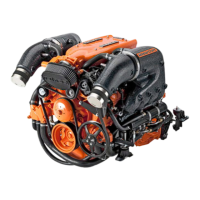SECTION 4 ILMOR MV8 OWNER’S MANUAL
4-2 © 5/2013 Ilmor Marine, LLC, Version 1.0
CHECK THE SEA STRAINER – PRE-ENGINE
START-UP
Because this process should be completed while the engine is cool (in order
to avoid burns), it is recommended that this check be completed prior to
starting the engine. If checking during an outing, allow the engine to cool.
Be very careful to avoid burns from contact with hot engine parts.
1. Ensure the engine is OFF and the engine safety starting switch is
disconnected. Leave the throttle/shi control lever in neutral.
2. Open the engine compartment and locate the seacock. Make sure this
is in the CLOSED position before proceeding.
3. Locate the sea strainer. Remove the cap/lid and check the screen for
debris. Remove any debris and rinse with water if necessary.
4. Reinstall the screen and screw on the cap/lid. Make sure the o-ring is in
place and do not overtighten.
5. Move the seacock into the OPEN position.
NOTICE: Make sure the seacock is back in the ON position. If this
operation is skipped, the engine will overheat, failing the raw water
pump impeller and causing severe engine problems. Make sure that
the cap/lid has been installed correctly and has not pinched the sealing
o-ring. This will cause air to be introduced into the system and could
cause the raw water impeller to fail, causing severe engine problems.
NOTICE: Always pay attention to any gauges or warning lights. Ignoring
elevated temperatures on a temperature gauge or any other evidence of
the engine operating at temperatures above recommended levels can
result in serious damage to the engine. Any resulting damage will not be
covered by the warranty.
NOTICE: This is a critical function of routine maintenance. Even clean-
appearing waterways may have debris such as pine needles or moss
that can enter the cooling system and create a blockage. Failure to
perform this function can result in serious overheating of the engine.
Damage to the engine and/or transmission caused by overheating is not
covered by warranty. Always pay attention to your temperature gauge,
even if you are carefully performing this check. Failure of the raw water
impeller or blockage of the transmission cooler are frequent causes of
overheating.
INCOMING
RAW WATER
OPEN
CLOSED
SEACOCK
STRAINER
TYPICAL SEACOCK AND STRAINER

